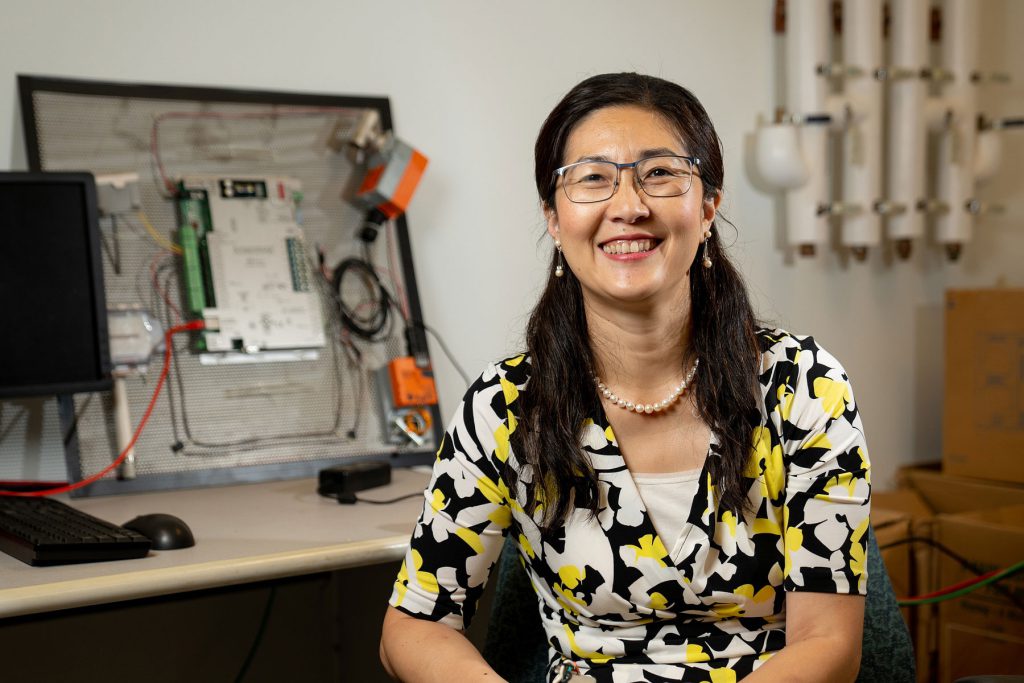A Drexel professor is creating data-driven solutions to optimize occupant comfort and ensure environmental responsibility.
The battle over the office thermostat has become so ingrained in corporate culture that it’s become cliché. But the reality behind the joke is: studies have shown that workers commit fewer errors when the indoor temperature is at the right level. While investing in building efficiency can not only improve the comfort of its occupants, it can also improve health, save money and be more environmentally friendly.
“There are many ways to make a building more efficient,” said Jin Wen, PhD, professor of civil, architectural and environmental engineering and associate dean for faculty advancement. “The most ideal way is to build it responsibly — for instance, make sure it is well insulated, or that you don’t have floor-to-ceiling windows that face south, where the most solar load will hit the building if you want to save cooling energy. But for existing buildings or for those that can’t be built to the most ideal specifications, other technologies can help.”
Smart buildings are not unlike smart homes, where wired, wireless or even internet-connected thermostats and light bulbs can be controlled remotely and, to a certain extent, learn your schedule to optimize your home based on occupancy. At the building scale, sensors applied to all of a building’s systems — HVAC, plumbing, lighting, security and more — can work together to keep complex building systems running at peak efficiency. But knowing what kinds of sensors a building needs, and how to convert raw sensing measurements (data) into useful information which lead to better building performances, is where Wen’s expertise comes into play.

“Your baseline sensors for good building management include temperature, humidity, pressure, flow rate and power,” Wen explained. “But there are more innovative sensors that can be used. For example, I am working with collaborators at Clemson University to develop extremely low-cost and low-power-consumption sensors that can provide comprehensive indoor environment measurements.
“We are also working with collaborators at the University of Hawaii to develop non-intrusive sensors that understand occupants’ stress level and use this information. Just knowing the temperature measurement alone does not lead to efficient buildings. I am interested in using the data to know whether a temperature reading is normal, or whether this indicates that your cooling valve is leaking, or occupants are engaging in a certain activity, as the real “smartness” that helps to alert management, or adjust the room temperature, lighting and noise level when these anomalies are detected.”
The anomalies are especially important to building managers, who, in many cases today, don’t have the tools to know when something is going wrong before it is too late.
“Imagine that you have a small leak in one of your heating coil valves,” Wen suggested. “It will leak a very small amount of hot water through heating coils warming up the duct air even during the summer. It’s not in a place that you’d notice it, nor is it enough to start a flood or make something seem unnaturally damp. So you don’t notice it until your energy bill comes in a month later and it’s suddenly higher because you spent all this energy heating water that was leaking away and also spent the same amount of cooling energy to counter the heating effect.”
Energy monitors may be able to tell you that there’s something inflating your energy use but might not know what is causing it. By employing the right sensors and developing the intelligence using machine learning and cloud computing — the building itself may be able to identify abnormal energy usage and find the root of the problem.
This combination of sensors, artificial intelligence and human interface tools is something that Wen and her colleagues have dubbed the Building Doctors’ Medicine Cabinet. These building doctors are anyone who works on a building system — facilities managers, technicians, service people and commissioning engineers. The “medicine cabinet” is a set of diagnostic tools that Wen has developed in collaboration with information scientists at Arizona State University and mechanical engineers from Texas A&M that can translate the oversized swarm of data that the sensors put out into actionable recommendations for the building doctors.
Creating this kind of robust, self-sufficient smart building suite is easier said than done. In the United States, even newer buildings aren’t always loaded with the digitized sensors into the system Wen envisions. That’s why, with the help of a Fulbright grant in 2019, Wen traveled to Sweden to work with experts at the KTH Royal Institute of Technology in Stockholm to test her data-driven approach to building management on one of their buildings.
“In just one winter pilot test, we were able to reduce the building’s heating energy use by 50 percent during its unoccupied time,” Wen said. “Just studying the building and learning the ideal heating supply water temperature to maintain so it could be recovered to an appropriate level when it was occupied, saved a lot of energy.”
Wen has since brought her toolkit back to the United States, where she is now working with other partners such as researchers from Texas A&M, and Slipstream, a nonprofit consulting firm focused on delivering climate-friendly energy solutions to underserved communities. They are currently writing a proposal to use the tools to design better energy systems for low-income housing.
“Too often, houses meant for low-income programs are built cheaply, they aren’t insulated properly, sealed correctly, and they don’t have the most efficient systems in place,” she said. “This can lead to poor health outcomes for those who live in these homes — we see a rise in asthma in these communities, for instance, because of poor air quality. We also see people having to choose whether to buy food in the winter or heat their homes because the houses leak heat and are too expensive to keep warm. If my data–driven solutions can encourage builders to build these houses responsibly or give building managers a better understanding of how to efficiently run their buildings so that it helps the people living there, that’s an outstanding outcome.”


